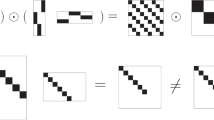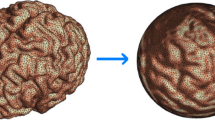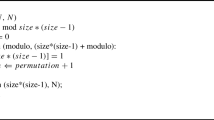Abstract
This paper describes a partitioning method for solving a class of structured nonlinear programming problems with block diagonal constraints and a few coupling variables.
The special structure of the constraints is used to reduce the given problem by elimination of variables. In variance to other methods proposed previously, this elimination is effected through the use of the general solution to an underdetermined system of linear equations representing the active constraints at a given feasible point. For weakly coupled systems, this arrangement provides a drastic reduction in the number of variables. The solution to the overall problem is obtained by solving a sequence of the reduced nonlinear programs. Primal feasibility is maintained throughout the optimization procedure. Computational experience and results are presented.
Similar content being viewed by others
References
A.M. Geoffrion, “Elements of large scale mathematical programming”,Management Science 16, No. 11 (1970) 652–675.
G.B. Dantzig and P. Wolfe, “Decomposition principle for linear programs,”Operations Research 8 (1960) 101–111; Also see G.B. Dantzig and P. Wolfe, “The decomposition algorithm for linear programs,”Econometrica 29 (1961) 767–778.
J.B. Rosen, “Partition programming,”American Mathematical Society — Notices 7, Abstract No. 572-22 (1960) 718–719.
J.B. Rosen, “Convex partition programming,” in: Eds. R.L. Graves and P. Wolfe,Recent advances in mathematical programming, McGraw-Hill, New York, 1963, pp. 159–176.
O.L. Mangasarian,Nonlinear programming (McGraw-Hill, New York, 1969).
M.D. Grigoriadis, “A projective method for a class of structured nonlinear programming problems,” IBM New York Scientific Center Report No. 320-2992 (1970).
H.W. Kuhn and A.W. Tucker, “Nonlinear programming,”Proceedings of the second Berkeley Symposium of mathematical statistics and probability (University of California Press, Berkeley, California, 1951).
J.B. Rosen, “The gradient projection method for nonlinear programming, Parts I and II”SIAM Journal on Applied Mathematics 8, No. 1 (1960) pp. 181–217; and 9, No. 4 (1961) 514–532.
D. Goldfarb, “Extension of Davidon's variable metric method to maximization under linear inequality and equality constraints,”SIAM Journal on Applied Mathematics, 17, No. 4 (1969) 739–764.
G. Zoutendijk,Methods of feasible directions (Elsevier Publishing Company, Amsterdam, 1960).
W.I. Zangwill,Nonlinear programming — a unified approach (Prentice-Hall, Inc., Englewood Cliffs, New Jersey, 1969).
O.L. Mangasarian, “Equivalence in nonlinear programming,”Navals Research Logistics Quarterly 10, No. 4 (1963) 299–306.
G.B. Dantzig,Linear programming and extensions (Princeton University Press, Princeton, N.J., 1963).
D.A. D'Esopo, “A convex programming procedure”,Naval Logistics Research Quarterly 6, No. 1 (1959) 33–42.
D.J. Wilde,Optimum seeking methods (Prentice-Hall, Englewood Cliffs, New Jersey, 1964).
J. Warga, “Minimizing certain convex functions,”SIAM Journal on Applied Mathematics 16, No. 1 (1960) pp. 588–593.
R. Hooke and T.A. Jeeves, “Direct search' solution of numerical and statistical problems,”Journal of the Association for Computing Machinery 8, No. 2 (1961) 212–229.
P. Fauré and P. Huard, “Résolution des programmes mathématiques a fonction nonlinéaire par la méthode du gradient réduit”,Revue Française de Recherche Opérationnelle 9 (1965).
J.B. Rosen, Private communication (January 1970).
J.B. Rosen and S. Suzuki, “Construction of nonlinear programming test problems,”Communications of the Association for Computing Machinery 8, No. 2, (1965) pp. 113.
M.D. Grigoriadis, “A dual generalized upper-bounding technique”,Management Science 17, No. 5 (1970) 269–284.
E.H. Moore, “General analysis (part 1),”Memoirs of the American Philosophical Society, Vol. 1 (1935).
R. Penrose, “A generalized inverse for matrices,”Proceedings of the Cambridge Philosophical Society 51 (1955) 406–413.
T.N.E. Greville, “The pseudoinverse of a rectangular or singular matrix and its application to the solution of systems of linear equations,”SIAM Review 1, No. 1 (1959) 38–43.
G.B. Dantzig, “Upper bounds, secondary constraints and block triangularity in linear programming,”Econometrica 23, No. 2 (1955) 174–183.
J.B. Rosen, “Primal partition programming for block diagonal matrices”Numerische Mathematik 6 (1964) 250–260.
K. Ritter, “Structured quadratic programming problems,” Mathematics Research Center Report No. 718, The University of Wisconsin, Madison, Wisconsin (January 1967).
G.B. Dantžig and R.M. Van Slyke, “Generalized upper bounding techniques”,Journal of Computer and System Sciences 1 (1967) 213–226.
R.N. Kaul, “An extension of generalized upper-bounded techniques for linear programming,” Operations Research Center Report No. 1965-27, University of California, Berkeley, California (1965).
M.D. Grigoriadis and K. Ritter, “A decomposition method for structured linear and nonlinear programs”,Journal of Computer and System Sciences 3, No. 4 (1969) 335–360.
Author information
Authors and Affiliations
Additional information
This work was supported in part by the National Science Foundation under Research Grant GJ-0362 and in part by the New York Scientific Center, IBM Corporation.
Rights and permissions
About this article
Cite this article
Grigoriadis, M.D. A projective method for structured nonlinear programs. Mathematical Programming 1, 321–358 (1971). https://doi.org/10.1007/BF01584096
Received:
Revised:
Issue Date:
DOI: https://doi.org/10.1007/BF01584096




